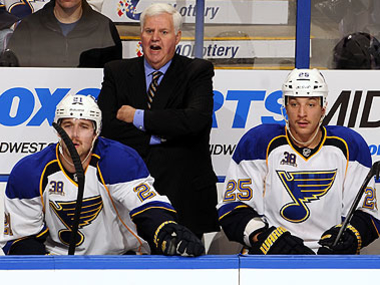It wasn’t enough to outlaw blindside hits to the head. It wasn’t enough to outlaw all targeted hits to the head, to broaden the boarding rule, to give a video explanation of each suspension. The NHL is still too much of a demolition derby, and concussions continue to be a crisis.

So when the league’s general managers hold their annual March meeting next week in Boca Raton, Fla., they will discuss whether to go back to their roots. Should they reintroduce the red line to outlaw two-line passes? Should they eliminate the trapezoid behind the net to allow goaltenders to play the puck in the corners again? Should they do something else?
“The game is fast,” said Detroit Red Wings GM Ken Holland. “We want the game to be fast. But how do you get the game to be a little bit controlled?”
These are good questions, and they need to be asked whenSidney Crosby has played only eight games in more than a year, when so many other players are suffering from concussions –Chris Pronger,Nicklas Backstrom,Jonathan Toews, on and on and on.
“My opinion is that we should discuss it,” said Boston Bruins GM Peter Chiarelli. “I think we’ve done a lot of different things to speed up the game. I think maybe looking at putting [the red line] back in, in some way shape or form, would help moderate the speed.”
But there seems to be no consensus within the league. There isn’t a consensus within organizations. Take the Red Wings: Holland isn’t a big fan of reintroducing the red line; his coach, Mike Babcock, is. Some think it would make the game safer and more aesthetically pleasing; others doubt it.
If the experience of the past decade has taught us anything, it’s that the game evolves and rule changes can lead to unintended consequences. You can look back for solutions – and you might find some there – but the real trick is thinking a step ahead.
The NHL changed the rules after the 2004-05 lockout to open up the game. Coaches learned how to exploit them. Teams now fire the puck up ice to the far blue line. One player tips the puck into the offensive zone to avoid icing, while forecheckers race ahead unimpeded. They smash into the defensemen, who are racing back and can’t be helped by a goaltender who can’t play the puck.
It’s dangerous. It’s also unimaginative.
“If you want more puck possession in the game, you’ve got to bring the red line back in the game so there’s more control,” said St. Louis Blues coach Ken Hitchcock. “It slows down a little bit. Second thing, the big hits on the defensemen, it comes from the middle of the ice. It doesn’t come from the walls. It comes from the middle of the ice.”
In theory, the red line would force players to carry the puck up ice. It would keep forecheckers from gathering so much speed and closing on defensemen so quickly. Without the trapezoid, goaltenders could relieve some of the stress on their defense.
The argument is that the new rules didn’t increase offense much in the long run, so going back to some of the old rules wouldn’t decrease it that much, either. There is less of an appetite for allowing some level of obstruction to creep back into the game, because it is more of a gray area and a slippery slope. Players would still be freer to make plays than in the past.

Blues coach Ken Hitchcock says the return of the red line would lead to more excitement and fewer injuries.(Getty Images)
“I’d put [the red line] back,” Hitchcock said. “I’d put it back in for sure. It’d add to puck possession, and it would really decrease accidents. … You’re going to have more rush attacks, more puck-possession attacks and less chip and dip.”
But some are unconvinced that the lack of the red line is a root cause of concussions.
“In theory, I understand it,” said Chicago Blackhawks GM Stan Bowman. “I don’t know in actuality. Is that why there’s been injuries? Because of the red line? Or is it more that there’s no obstruction? … I don’t know if there’s a correlation between the red line and injuries. … If you really broke it down, I’m not so sure that allowing the stretch pass is going to result in more concussions.”
Others are worried that reintroducing the red line would lead to teams clogging up the middle again, like Hitchcock’s Dallas Stars used to do.
“I think actually it would hurt the game, putting the red line back in, to be honest, because of the fact that you could just back up and keep everybody in front of you,” said Nashville Predators coach Barry Trotz. “Now they can spread you out, and it allows the skill players a little bit more room.”
Then there are those who wonder whether the red line would really slow down the game and lead to more playmaking. It’s nice to think there would be Harlem Globetrotters hockey in the middle of the ice. It’s nice to think that goaltenders would relieve the stress on their defense if they could play the puck in the corner. But how many teams have that many playmakers? How many teams have goaltenders who are that skilled?
Coaches like low-risk strategies that can be employed consistently by everyone in the lineup. They have learned that their odds are better if they get the puck into the offensive end as quickly and efficiently as possible, and they aren’t going to unlearn that even if the red line comes back.
Instead of allowing players to carry the puck through the middle – where they can commit dreaded neutral-zone turnovers, especially with today’s back pressure – coaches might just find new ways to get the puck deep and chase with speed. Perhaps they’ll have somebody chip in the puck at the red line instead of the far blue line. Perhaps forecheckers will still be racing in so fast that goaltenders won’t be able to play the puck in the corners even without the trapezoid.
“Coaches are paid to win, right?” said Phoenix Coyotes coach Dave Tippett. “The hitting part and the safety part, to me, that’s out of the coaches’ hands. You can have rules that dictate things. But … it’s a tactical battle as much as a physical battle. The thing is now, every team is tactically sound. Every team is prepared.”
Remember, the GMs have been discussing these same subjects for at least two years. They might decide they need to go further after they receive another study breaking down the causes of concussions. They also might decide that they have made many rule changes already and that they’re starting to work, and they might want to see if equipment changes like lighter shoulder pads can have an effect.
“There is more speed,” Trotz said. “Because there is more speed, there is a little more contact, especially for defensemen going back. But now that we have the NHL police on head injuries, I don’t think the game’s very physical at all right now compared to what it was 10 years ago.”
They also might come up with something different. Years ago, legendary coach Scotty Bowman suggested borrowing a rule from ringette. You can’t pass from behind your net to the far blue line. You have to work your way to a line at the top of the circles first. Holland recognizes that would change the game. He wonders how it would be officiated. He isn’t proposing it. But it interests him.
“I like it the way it is, I don’t like it the way it is,” Holland said. “I guess ultimately I’m interested in having further conversations.”
No comments:
Post a Comment